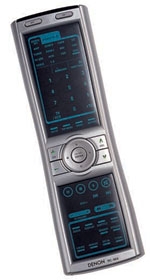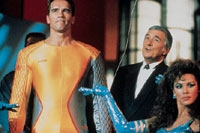Denon AVR-3805 Digital Surround Receiver Page 3
 Here's how it works: You place a small microphone at ear level in the prime listening position and start the auto-setup process. Short bursts of calibrated noise are sent to each speaker output in rotation, and from what the mike picks up (or not) from each speaker, the AVR-3805 determines the size of the speakers you have hooked up (for bass-management purposes), whether they're in phase, and how far each one is from the prime listening position. The system then calculates and adjusts the balances between the channels, including the subwoofer, using half-decibel steps, and compensates for speaker-distance variations in 1.2-inch increments.
Here's how it works: You place a small microphone at ear level in the prime listening position and start the auto-setup process. Short bursts of calibrated noise are sent to each speaker output in rotation, and from what the mike picks up (or not) from each speaker, the AVR-3805 determines the size of the speakers you have hooked up (for bass-management purposes), whether they're in phase, and how far each one is from the prime listening position. The system then calculates and adjusts the balances between the channels, including the subwoofer, using half-decibel steps, and compensates for speaker-distance variations in 1.2-inch increments.
The receiver will also automatically adjust an eight-band parametric equalizer applied to each main channel. You can choose between no equalization and three automatic-EQ settings. Auto-EQ sounds like almost as good an idea as the automatic speaker balancing, but in practice I found it a hit-or-miss proposition. Still, it doesn't hurt to try it out. And Denon makes it easy to cycle though and compare the three EQ settings or to leave out the equalization altogether.
All in all, the auto setup was remarkably accurate and produced sonic results that were just as satisfying as I got using the old-fashioned sound-level meter setup technique, which is also possible with the AVR-3805. Calculated speaker distances to the mike were usually within a couple of inches of their tape-measure lengths (the biggest error I got was about a foot), and the speaker balances came out within a decibel of each other when I checked them with a sound-level meter.
|
|
Denon's AVR-3805 is that rarest of components: an A/V receiver that's perfectly balanced between the conflicting demands of versatility and usability, between sheer audio performance and an affordable price. Using its ultra-cool, almost-buttonless, blue-backlit remote control (whose capabilities are conveniently duplicated on the front panel) together with its marvelous automatic-setup features, you can do a better job of setting up the AVR-3805 - and therefore achieve better sound quality - than is likely with many more powerful and costly receivers. Considering how comparatively difficult to set up and adjust some flagship models are, any pirate worth his eyepatch would steer directly toward the AVR-3805 instead, a not-so-hidden treasure.
PDF: In the Lab














































